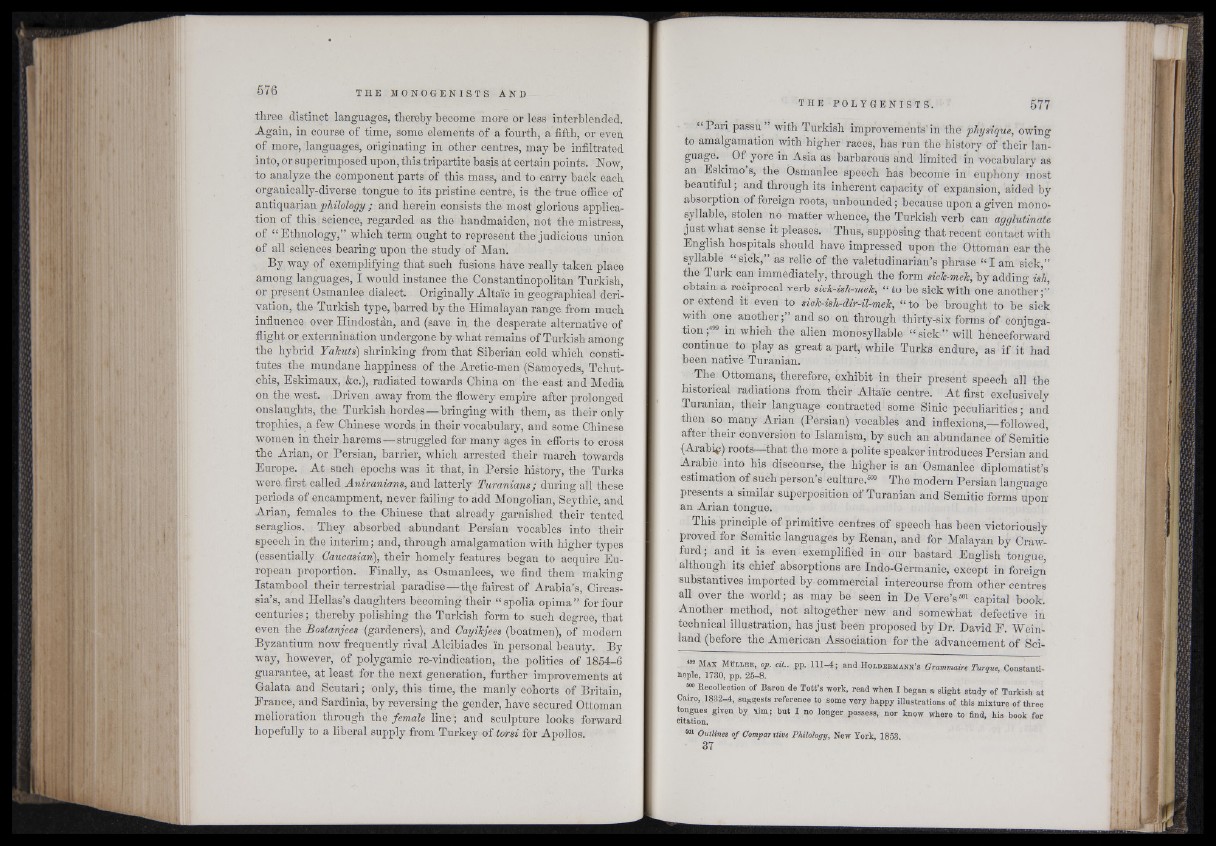
three distinct languages, thereby become more or less interblended.
Again, in course of time, some elements of a fourth, a fifth, or even
of more, languages, originating in other centres, may be infiltrated
into, or superimposed upon, this tripartite basis at certain points. Now,
to analyze the component parts of this mass, and to carry back each
organically-diverse tongue to its pristine centre, is the true office of
antiquarian 'philology ; and herein consists the most glorious application
of this, science, regarded as the handmaiden, not the mistress,
of “ Ethnology,” which term ought to represent the judicious union
of all sciences bearing upon the study of Man.
By way qf exemplifying that such fusions have really taken place
among languages, I would instance the Constantinopolitan Turkish,
or present Osmanlee dialect. Originally Altaic in geographical derivation,
the Turkish type, barred by the Himalayan range from much
influence over Hindostán, and (save in. the desperate alternative of
flight or extermination undergone by what remains of Turkish among
the hybrid Yakuts) shrinking from that Siberian cold which constitutes
the mundane happiness of the Aretic-men (Samoyeds, Tchut-
chis, Eskimaux, &c.), radiated towards China on the east and Media
on the west. Driven away from the flowery empire after prolonged
onslaughts, the Turkish hordes—bringing with them, as their only
trophies, a few Chinese words in their vocabulary, and some Chinese
women in their harems—struggled for many ages in efforts to cross
the Arian, or Persian, barrier, which arrested their march towards
Europe. At such epochs was it that, in Persic history, the Turks
were, first called Aniranians, and latterly Turanians; during all these
periods of encampment, never failing to add Mongolian, Seythie, and
Arian, females to the Chinese that already garnished their tented
seraglios. They absorbed abundant Persian vocables into their
speech in the interim; and, through amalgamation with higher types
(essentially Caucasian), their homely features began to acquire European
proportion. Finally, as Osmanlees, we find them making
Istambool their terrestrial paradise—tl^e fairest of Arabia’s, Circassia’s,
and Hellas’s daughters becoming their “ spolia opima ” for four
centuries ; thereby polishing the Turkish form to such degree, that
even the Bostanjees (gardeners), and Cayikjees (boatmen), of modern
Byzantium now frequently rival Alcibiades in personal beauty. By
way, however, of polygamic re-vindication, the politics of 1854-6
guarantee, at least for the next generation, further improvements at
Galata and Scutari; only, this time, the manly cohorts of Britain,
Erauce, and Sardinia, by reversing the gender, have secured Ottoman
melioration through the female line; and sculpture looks forward
hopefully to a liberal supply from Turkey of torsi for Apollos.
“ Pari passu ” with Turkish improvements’in the physique, owing
to amalgamation with higher races, has run the history of their language.
p Of yore in Asia as barbarous and limited in vocabulary as
an Eskimo s, the Osmanlee speech has become in euphony most
beautiful; and through its inherent capacity of expansion, aided by
absorption of foreign roots, unbounded; because upon a given monosyllable,
stolen mo matter whence, the Turkish verb can agglutinate
just what sense it pleases. Thus, supposing that recent contact with
English hospitals should have impressed upon the Ottoman ear the
syllable “ sick,” as relic of the valetudinarian’s phrase “ I am sick,”
the Turk can immediately, through the form sick-mek, by adding ish,
obtain a reciprocal verb sick-ish-mek, “ to be sick with one another;”
or extend it even to sick-ish-dir-il-mek, “ to be brought to be sick
with one another;” and so on through thirty-six forms of conjugation;
499 in which the alien monosyllable “ sick” will henceforward
continue,-to play as great a part, while Turks endure, as if it had
been native Turanian.
The Ottomans, therefore, exhibit in their present speech all the
historical radiations from their Altaic centre. At first exclusively
Turanian, their language contracted some Sinic peculiarities; and
then so many Arian (Persian) vocables and inflexions,—followed,
after their conversion to Islamism, by such an abundance of Semitic
(Arabip) mots that the more a polite speaker introduces Persian and
Arabic into his discourse, the higher is an Osmanlee diplomatist’s
estimation of such person’s culture.«10 The modern Persian language
presents a similar superposition of Turanian and Semitic forms upon
an Arian tongue.
This principle of primitive centres of speech has been victoriously
proved for Semitic languages by Renan, and for Malayan by Crawford;
and it is even exemplified in our bastard English tongue,
although its chief absorptions are Indo-Oermanic, except in foreign
substantives imported by commercial intercourse from other centres
all over the world; as may be seen in De Vere’s«11 capital book.
Another method, not altogether new and somewhat defective in
technical illustration, has just been proposed by Dr. David E. Wein-
land (before the American Association for the advancement of Scim
M a x M d l l e r , op. cit.. pp. 111-4; and H o id e km a h n ’s Grammaire Turgue, Constantinople,
1730, pp. 26-8.
“» Recollection of Baron de Tott’s wort, read when I began a slight study of Turkish at
Cairo, 1832-4, suBgests reference to some very happy illustrations of this mixture of three
tongues given by Him; but I no longer possess, nor know where to find, his book for
citation.
801 Outlines of Compar litre Philology, New York, 1853
37